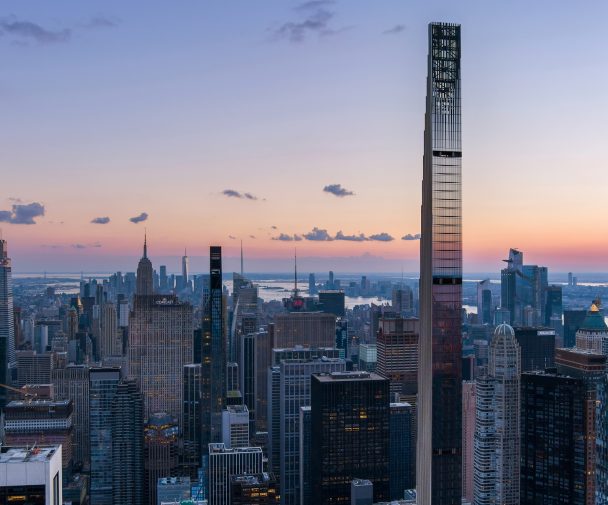
Next on the Block
Phillips Pulls Back the Curtain
Written by A J Sidransky | Imagery courtesy of studioMDA
The high-concept auction space designed by world-renowned architect Markus Dochantschi and his design firm studioMDA, is the ‘jewel-in-the-crown’ of Phillips’ move to 432 Park Avenue.Located on a viewable sunken mezzanine, the auction rooms offer a direct visual connection from the street.The cutting-edge space promotes architectural lucidity and public engagement. Coming off a memorable year, international auction firm Phillips’, plans to move into its new 55,000 square foot home in 2020, as part of a continuing strategy for growth.
studioMDA has worked extensively with renowned art collectors, artists and galleries to create innovative and provocative gallery and exhibition spaces.In designing this space, they have created a one-of-a-kind setting that transforms Phillips into a leading venue for experiencing art in New York.The innovative design brings transparency into the traditionally behind-closed-doors world of art and auctions.
Dochantschi considered numerous factors in creating this concept. “We have designed galleries for quite some time, over a dozen in New York City alone.We also do booths for art fairs world-wide, over 250 to date.When we design a booth, we consider such factors as the view line and making art accessible.At a fair you have limited time and space–it’s like a tradeshow–in which to display art.An auction house is a hybrid between a museum, a gallery, and a booth at an art show, so you need flexibility.And you must make it accessible to the outside. Create intimacy.”
“One of the primary goals for our new headquarters,” says Edward Dolman, CEO of Phillips, “was to create a space that could be truly transformative, addressing the ever-changing needs of our business. Phillips’ sales have increased 129% in the past four years, and with this new gallery we will be able to continue to adapt and grow in unprecedented ways – hosting more exhibitions, panel discussions, and events, in addition to our auction schedule.”

One of the unique architectural design features of the auction space is that it’s flexible, not static. “The space will give us the ability to display large-scale contemporary works in new and exciting ways, allowing us to innovate within the market,” says Dolman.Dochantschi and studioMDA created a system of flexible zones that can be divided into separate rooms or opened into a vast, column-free space for auction and exhibition activities. This is particularly beneficial to Phillips’ core business, as they hold auctions for various categories of collectibles ranging from contemporary art to photography to watches, which have different space and presentation needs.
“An auction house,” says Dochantschi, “differs from a museum in that you can see art–a specific piece of art–at a museum over and over again.At an auction, you see the art and will not see it again.”Dochantschi and studioMDA gained the opportunity to design this space through a competition.“We won the competition through our use of visual accessibility and our movement away through design from a fixed type of auction space to a flexible space.It is a hybrid between an art fair and a kunsthalle,” a German term for an art hall that can host different types of art presentations, ranging from paintings to jewelry to cars, for instance.“It’s a stage for art,” Dochantschi explains.
“Transparency and visibility are important priorities for Phillips, and we are so pleased that Marcus was able to create a space that reflected this core value,” added Dolman.“Phillips will be the only New York auction house where you can see an exhibition or auction taking place from the sidewalk, encouraging collectors, enthusiasts, and those who are completely new to the art scene to come in and experience the space.”
Traditionally, auction houses have been ‘siloed’ in nature, with distinctly separate collecting categories and auctions.Phillips’ continues to break down these barriers.“Collectors are increasingly looking to collect across different categories,” explains Dolman. “Right now, for example, we have jewelry, watches, design, and photographs all on view. People want to build well-rounded collections that reflect the very best of 20th century and contemporary art and design. It’s up to us to provide an environment where they can easily do just that.”

Another major factor is the advent of new technologies in communications.“It has been an absolute game changer in the auction business and collectors are constantly looking for new and efficient ways of acquiring information and building their collections. We need to have a space that allows for us to be nimble in adapting to the ever-evolving advances in the sector,” Dolman says.“Phillips’ has clientele all over the world, and the potential buyer in Hong Kong, for instance, may want to participate in an auction in New York.”
New technology and accompanying design provide that option. Dochantschi’s innovative architectural concept and its adoption by Phillips for their new headquarters is a giant step into the future for the art and auction world.
Related Articles

The Return of the Chain Stores
Real estate investors apprehensive about prospective tenants' timelines
Read More
ADVERTISE WITH EQ
ebunn@equicapmag.com
dhilpert@equicapmag.com
Popular Posts









